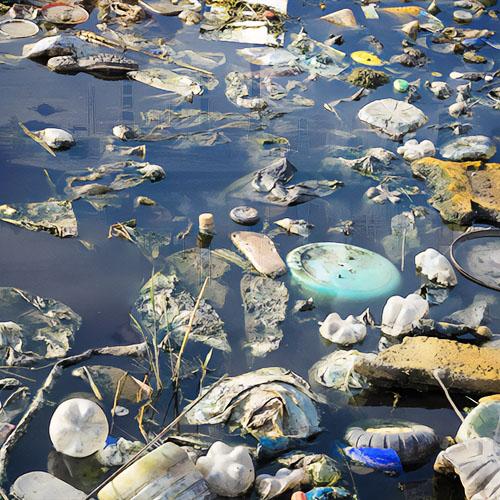It’s easy to shed tears at the movies over lost Indian cultures. But today, we have become unwitting accomplices in a little-reported scheme that will flood an area twice as large as Connecticut and exterminate the last real tribal hunters in north America.
Drowning the James Bay Wolves
At this late date near the close of the twentieth century — when scenes of the untamed west come to us only in fleeting images on television or the big screen — few of us know that a real culture of Indian hunter? Still exists in north America, living much as their forbears did hundreds of years ago. They are the Cree Indians of northern Quebec. And the James Bay Project had them directly in its sights.
And at a time when we shed tears over dances with wolves, when we voice outrage over the destruction of the Brazilian rain forests and profess our solidarity with the endangered species of the planet, even fewer of us realize that we may be financing the extermination of the Cree hunting culture — one of the last pure vestiges of north America’s pre-European past. In fact, the same electricity that powers our stereos when we rock to the sounds of sting is also the source of the Cree’s demise.
For the past 5,000 years — three millennia before the birth of Christ — the hunters and trappers of the Cree Indians of northern Quebec have evolved a culture both simple and rich, intimately tied to the land and the animals upon which they depend for survival. Anthropologists say that few other people since the dawn of human-kind have managed their resources better than the Cree, no one else has persevered in a single habitat for so long without endangering its wildlife or sacking the environment.
Trapping rabbits in the dead of winter, stalking caribou in the down-pours of autumn, spearing trout — from rushing brooks in the brief summer thaw, Cree hunters have survived on the margins of our continent, by-passed by the stampede of civilization that has elsewhere run rampant. Until recently, the sheer isolation of Quebec’s Ungava peninsula and the harshness of its climate protected the Cree from the penetration of white settlers.
But now a white invasion is on in earnest: engineers in hard hats, robust workers wheeling mammoth earth-moving and tree-cutting machines, gray-flanneled bureaucrats bearing blueprints, contracts, and welfare checks. The developers have their sights set on unlocking the hydroelectric potential bound up in the vast web of rivers that form the transportation routes and nourish the hunting grounds on which the Cree hunters depend.
Construction is already nearing completion on the first phase of the James Bay Project, as it is called, on the La Grande River, some 700 miles north of Montreal. The next phase — James Bay II — is scheduled to begin within the coming year. This phase would expand the James Bay Project to other major river systems, both north and south of the La Grande. By the year 2006, the projected completion date, Hydro-Quebec hopes to generate 26,000 megawatts — the equivalent of 25 nuclear power plants — in the James Bay region.
The electricity would power industrial development and provide service to consumers throughout eastern Canada and the United States. Already, several utilities from the Great Lakes to New England have signed billion-dollar contracts for Quebec’s hydropower. Since little has been reported in the United States about this massive project, we have become unwitting accomplices in one of the most bitter controversies involving the environment and native rights ever to shake our oft-ignored neighbor to the north — Canada.
Environmentalists have joined ranks with the Cree in opposing the project. They call it the “northern equivalent of the destruction of the tropical rain forests.” Developers downplay the potential for lasting environmental damage. But critics say the region’s rich tapestry of woodlands, water, and wildlife will be overwhelmed by the massive scale of the project, which envisions damming or altering the course of every major river — more than a dozen in all — that drains into the James and Hudson bays. An area nearly twice as large as Connecticut would be flooded, and a wilderness region the size of France transformed.
Ecologists and other critics of the James Bay Project fear that massive tampering with the subarctic environment will produce these results:
- Crucial calving grounds for the world’s largest herd of caribou will be flooded and migratory routes disrupted. In 1984 10,000 caribou drowned in the unnaturally swollen Caniapiscau River, diverted from its original course to feed the La Grande system.
- Increased silt from the rivers will settle in the shallows of James Bay, burying sea grass, clams, and mollusks — vital food sources in the most important feeding and nesting grounds in the hemisphere for millions of migratory geese and ducks.
- The flooding of vast woodlands will release millions of tons of carbon dioxide and methane into the atmosphere, furthering the greenhouse effect and global warming, while removing millions of trees that absorb those gases and replace them with oxygen.
- Unstable salinity — the result of reversing the natural, seasonal flow of fresh water in the James and Hudson bays — could endanger ringed and harbor seal as well as one of the world’s largest herds of beluga whales.
- The lakes that host the hemisphere’s only known species of freshwater seal will be flooded, endangering the animals.
- Thousands of miles of lakeshores and riverbanks — the prime habitat for beaver, lynx, fox, and partridge — will be flooded. Fluctuating water levels in the reservoirs and river ways will replace lush shorelines with hundreds of square miles of sterile mud flats, incapable of sustaining plant or animal life.
- The flooding of woodlands also releases toxic methylmercury, which poisons fish and water. Bacteria working on the rotting vegetation interact with inorganic mercury in the soil to produce the toxic mercury. In the La Grande River, fish that once formed staples in the Cree diet — trout, pike, and pickerel — now contain dangerously high levels of mercury. Health officials have counseled the Cree to refrain from eating river fish. It may take decades, perhaps even a century, before the fish are safe to eat once again.
- The roads necessary for moving equipment to construction sites will open up the Cree’s ancestral hunting grounds — and eastern North America’s last great wilderness area — to mining, logging, and white hunters from the south, further endangering the delicate balance maintained by the native hunters for thousands of years.
At a time when continuing reliance on imported oil would amount to nothing less than collective insanity, the James Bay Project — with its vast potential for renewable and seemingly non-polluting electricity — appears to offer a promising alternative. We rarely associate environmental or social damage with hydroelectricity. Our utility bills routinely advise us of the savings incurred through the purchase of “clean” hydro-power from Canada.
“If the project goes through, everything we have, everything the Cree love, will be lost. Everything will be underwater… I’m thinking about my kids, and if they have kids.”
But Robert Mainville, a Montreal lawyer who works for the Cree, sees the economic downside. He contends that Hydro-Quebec is stampeding the province into a multibillion-dollar boondoggle that will virtually starve other areas of Quebec’s economy. “It’s very worrisome from the point of view of management and public spending,” he says.
The total cost of the James Bay II Project is expected to exceed $40 billion, in addition to the nearly $20 billion already owed on the La Grande complex. The money will be raised in foreign markets — fully guaranteed, high-interest bonds. Mainville accuses Hydro-Quebec, the principal holder of the province’s spiraling debt, of pursuing a Third World-style, single-resource export economy that will strap Quebec taxpayers for generations to come.
Critics in the United States say the project will also drain local economies in the Northeast, all the while sapping efforts to curb our demand for energy. These critics say that the $26 billion in contracts that U.S. utilities have already signed with Hydro-Quebec would be better spent on conservation measures. “Demand-side management,” as this approach is called, would generate more jobs at home, keep the money in the local economy, and stimulate development of energy-saving technologies.
Recent studies here and in Europe seem to bear out these conclusions. The New York State Energy Office, for example, estimates that for every $1 million spent on demand-side measures, roughly half would end up as earnings back in the state’s economy, while creating 20 to 30 full-time jobs per year.
To get a better idea of the stakes involved in what would prove to be the world’s largest hydroelectric project, I traveled into the depths of Cree country earlier this year for a firsthand look. The journey yielded a unique perspective — one that allowed me a glimpse back into an ancient past, when man’s life was harsh but simple, and then forward into an insecure future that is already upon the Cree. This future will have stripped these relatively self-sufficient hunters of their livelihood to force them lockstep into the world’s economy.
Quebec’s Great North in midwinter was about as far away as I could get from the steamy jungles of Central America, where I had spent the previous seven years as a correspondent. But the frigid pinelands, with their primeval hunters, now provide less of an adventure, and the demise of the Cree only slightly less disturbing a story, than the dispatches I’ve filed about the carnage visited on the unfortunate natives of Nicaragua, El Salvador, and Guatemala.
The Cree’s past is a deep one. The arrival of Christopher Columbus in America is a relatively recent event when laid out against the Cree’s prehistoric origins. At night in the forest, when Cree elders spin tales in the glow of campfires, they tell of strangers from afar who once visited their ancestors. Their tales speak of mysterious, blond-haired oarsmen who, long ago, appeared from the north in longships, then left one day without ever coming back.
Several generations — centuries — would pass before the White Man made his next appearance. The next intruders came from the south — English-speaking trappers and traders from the Crown’s Hudson Bay Company. In the seventeenth century, the company established outposts on the fringes of the black-spruce forests, along the James and Hudson bays. The company did a brisk trade with the Cree — exchanging hatchets, cornmeal, and muskets for the rich supply of pelts the natives would bring in from the bush.
Contact with the company did bring some changes. The Cree pitched tents on the grassy shores around the trading posts and settled there for the summers. But by late August, when the cold winds began to blow, they would be off again, entire families paddling canoes upstream through the maze of rivers to their hunting grounds deep in the interior. Despite contact with the White Man — wemistikuusuu — the Cree remained a peaceful and semi-nomadic people. Rifles replaced their bows and arrows, but they continued to range across the land in pursuit of the animals they revered — the rabbits, caribou, moose, and beaver that fed them, clothed them, and provided the hides that covered their tepees and bush houses. Then, about 20 years ago, the Cree awoke one day to find engineers plowing back their forests, and things haven’t been the same since.
What Hydro-Quebec has already done to develop the waterways of the Great North is in itself staggering. A 90-minute flight in a jetliner takes you the 700 miles north from Montreal, above a sprawling landscape of lakes and forests, to La Grande 2 — site of the largest dam in the La Grande system. A tangle of transformers, huge erector-set electrical towers, and power lines crisscross the land, zinging with 10,000 megawatts of power bound for destinations as far south as New Jersey.
The prefabricated town of Radisson, temporary home to thousands of Hydro workers and engineers, lies nestled nearby under a snowcapped ridge. There is a long, winding highway that stretches all the way back to Montreal, built by Hydro-Quebec for moving its equipment to the La Grande Basin. This is the northernmost point the road reaches in eastern North America.
I was treated to a helicopter ride to get a better look at the facilities. We buzzed over the mile-and-a-half-long, 500-foot-high dam that plugs the La Grande River at L.G. 2. A reservoir the size of Rhode Island sprawls behind the dam, one of five artificial lakes in the La Grande complex. The chopper dipped and we ran down through an enormous stairway blasted out of solid granite — the spillway that discharges a roaring cascade during the spring melt. It’s a kind of safety valve to prevent an overflow at any of the 200 dikes and nine dams that control the waters of the La Grande system. In the dead of winter, only scattered icicles, each the size of a small waterfall, hung from the spillway’s 30-foot-high stairs.
Construction continues at L.G. 2, where Hydro-Quebec is in the process of adding another six generators to the 16 already online. It is the largest underground powerhouse in the world, and the fourth-largest hydro station anywhere on the planet. And this is only one segment of the 500-mile-long chain of artificial lakes that make up the La Grande complex. By 1995 the total capacity along the La Grande will reach 14,800 megawatts.
My hosts took me underground, into a huge vault blasted deep in the granite to house the turbines. The cavern is a massive, doomsday-style grotto straight out of a James Bond flick, dwarfing the giant earth movers still in the midst of creating it. I could understand why this project inspires pride among Hydro’s workers, who view the James Bay development as the driving force that will power the economy of an evermore independent Quebec.
The next day my guide, Guy L’ltalien, drove me farther west along the La Grande to the construction site of La Grande 1. Here, engineers are constructing a dike nearly two miles long to funnel the La Grande’s waters into the station’s turbines. The dead of winter used to bring the mighty La Grande to a frozen standstill. Now, with the flow of four other rivers diverted into the La Grande hundreds of miles upstream from here, the water rushes through L.G. 1 at terrifying volumes to meet winter’s peak demand for energy. In the nose-stinging cold of winter, water surges past at four times the natural seasonal rate, lifting a surreal cloud of steam into the frigid air.
On the road to L.G. 1 stands a huge boulder, chiseled in the shape of an upward-pointing arrowhead. L’ltalien said the rock was a memorial to an ancient Cree burial ground that will be swallowed by L.G. 1’s reservoir. A turnoff appeared on our right, toward the north, where a wide swath of pines were bull-dozed back, cutting an ugly path into the forest. “That’s where the road to Great Whale will begin,” L’ltalien said. The Great Whale River, 150 miles to the north, is the first objective in Hydro-Quebec’s proposed expansion of the James Bay Project.
I pictured the place in summertime, imagining masked Indians brandishing AK-47s — like the Mohawks who threw up barricades last year near Oka, Quebec, to stop the expansion of a golf course onto a sacred burial ground. Some Cree have vowed that they will do everything possible to prevent the northerly expansion of the project. It’s a threat that most Hydro-Quebec officials I met, including L’ltalien, do not take seriously. At least not yet.
Massive cranes rise up out of the steam clouds at L.G. 1. Another prefab workers’ colony rings the construction site. The facilities are replete with a visitor’s center, which receives thousands of guests every year, including corporate C.E.O.s and even heads of state. The center is a sort of mini-museum, with spot-lit displays of the region’s teaming wildlife.
The center even has a Cree Indian guide, Joe Moses, who escorts his guests past each stuffed animal, explaining the species’ significance to the Cree hunting culture. There are plastic replicas of the river’s abundant fish, and scale models of a tepee and a wiskajonjoap, a typical Cree bush house.
In fact, the very species the project is said to be endangering — including that of the ancient Cree hunter — are all here, sanitized, taken indoors, and placed on view for Hydro-Quebec’s visitors.
I took leave of L’ltalien and was greeted in the parking lot by Larry House, a hefty but affable Cree in his early twenties. House had volunteered to take me to Chisasibi, a Cree village 15 miles to the west, where the La Grande finally empties into James Bay. House scoffed at Hydro-Quebec’s public relations pavilion. “That guy in there, Joe Moses,” he said, “they’re using him so they can say they have Cree people working there.”
We drove past a roadblock manned by a pair of tough-looking Indians. A crudely painted sign hung on the booth: ENTERING CREE LAND. House explained that the local Cree government in Chisasibi was trying to stop boot-leggers bearing liquor and drugs — and unwanted whites.
House launched into a litany of complaints about Hydro-Quebec. He took me along the river and pointed to a massive rock jutting into the water. He said the outcrop was a traditional fishing area that Hydro had promised to leave intact. Now the rock’s face was blasted away, leaving a steep 40-foot cliff that seemed to hover above the eerie steam clouds. “The river was our lifeline,” House said. “People used to live along the river. That’s all been destroyed.”
As we entered Chisasibi, I thought I was driving into a pricey Vermont ski village. Modern houses sat deep in the snow in circular clusters. Kids with fluorescent parkas zoomed down the streets in snowmobiles. A huge replica of a tepee, with massive beams representing the poles, towered like a giant cone above Chisasibi’s chalet-style homes. “That’s the biggest symbol of our decadence,” House offered, dead-pan. The tepee housed a sizable two-story structure at its base — the town’s community center. A lack of funds has prevented the town from installing the doors to the entrance, and it remains closed. But House was speaking in broader terms.
“An area nearly twice as large as Connecticut would be flooded, and a wilderness region the size of France transformed.”
Whatever action the town has to offer now revolves around its commercial center — a small, modern shopping mall that features a supermarket, a fast-food grill, and the Northern, the Kmart-style offspring of the old Hudson Bay store. (Along with more useful items like snowshoes, the Northern now offers plastic-faced Eskimo dolls made in China and a full line of Teenage Mutant Ninja Turtle accessories.) With House, I leaned over the mall’s second-story balcony, watching the town’s seasoned hunters mill about, smoking cigarettes, making small talk.
As the first stage of the La Grande project neared completion in the late 1970s, Hydro-Quebec officials feared that the increased flow of water would wash away the island in the river’s mouth, where Chisasibi’s residents were then living. The government urged the residents of Fort George island to relocate to the mainland. A brand-new suburban-style village — Chisasibi — was built for Fort George’s 1,000 natives. By our standards life had improved in many respects for the Indians of Chisasibi. They now have modern homes with central heating, televisions, a school, and a hospital. But the sudden thrust into the twentieth century proved traumatic for a people used to an age-old, semi-nomadic life of hunting and fishing.
Many of these elders — who once spent the year hunting and trapping in the bush — have lost their hunting grounds to the floodwater upstream. Thousands of miles of riverbanks and wetlands — the best terrain for hunting game and trapping beaver, mink, and partridge — are now submerged. And since water levels fluctuate enormously — up to 40 feet from maximum capacity to low point during the spring drawdown — waterfront habitats are never able to regenerate. The flooding poisoned La Grande’s fish. Two-thirds of the Cree living along the La Grande have mercury levels greater than the limits stipulated by the World Health Organization.
The natives were able to wring a comprehensive land-claim settlement from the Quebec government in 1975, midway through the construction of the La Grande complex. The deal ceded most of the 400,000 square miles of northern Quebec to the provincial government. In return, the Cree and their Inuit neighbors farther north were compensated with $220 million. They were permitted to retain sovereignty over the lands adjacent to their settlements, and retained exclusive hunting rights over wide stretches of the territory. The government offered monetary incentives to full-time hunters to stay out in the bush, and the natives retained local control over their educational, health care, and local law-enforcement systems.
According to the agreement, any further large-scale development in the region would be subject to vigorous environmental review. The agreement also called for the preservation of the traditional Cree and Inuit cultures. The Cree took this to mean that their own consent would be required before any further development could proceed. That’s not how Hydro-Quebec understands it.
The elders of the Chisasibi now watch with quiet despair as their traditional values of family and community — forged through centuries of intimate contact with the land — give way to a new and terrifying world. They do not know what to teach their children and grand-children. What they do know has little relevance to life in Chisasibi, with its rampant consumerism and substance abuse.
“No one up here had any idea what the extent of the damage would be,” said one Cree leader. “Before the project, we only knew about dams from watching beavers build them.”
A collective malaise hangs over Chisasibi, infecting young and old alike. Sherman Hodier, a Chisasibi hunter who supervised Cree work gangs for Hydro-Quebec as they cut down trees on the river bottom before the flooding, says his workers were filled with remorse as they clear-cut their ancestral forests. “They didn’t feel right about it,” Hodier said. “They were cutting down the forests where they had their camps, where they had grown up, where they had hunted all their lives.”
The architects from Montreal who designed Chisasibi hoped to preserve some semblance of the old community’s traditions. They built the houses in circular clusters, each cluster forming a neighborhood. But most of Chisasibi’s residents seem lost in their own town. Eight years after moving to Chisasibi, Hodier still doesn’t know where most of his former neighbors live. “People don’t help each other anymore,” Hodier lamented. “No one knows where anyone lives. Maybe you run into friends at the shopping mall and say hello, but that’s it. Most people stay at home now and watch television.”
“You can imagine how lost these people must feel,” one French-speaking teacher from Montreal told me the next day. “Think what it would be like for us if, all of a sudden, our homes, hotels, and cars were taken from us and we were forced out to live in the bush. We would be just as lost.”
Some of the 150 white teachers and technicians working in Chisasibi feel that they present the most visible target for a vague, seething resentment. A latent panic is current among the whites. Among themselves, they whisper rumors that secret “warrior” gangs are emerging among the Cree, preparing to battle Quebec authorities if the bulldozers begin to push back the forests to clear the way to Great Whale.
The mouth of the Great Whale River is a sight to behold, especially in the deafening silence of deep winter. In the bone-chilling cold, I stood on the barren heights overlooking the vast, frozen expanse of the Hudson Bay with Elijah Shushamush and three other Cree hunters. Below us to the left, we could make out the final mile or so of the broad Great Whale, a massive white tongue that pried its way between two snow-covered ridges before joining with the boundless Hudson Bay. We were so far north that at 300 feet above sea level, we had left the tree line well below us.
The sheer enormity of the landscape confounded my efforts to imagine the bitter controversy stirring in far-off courts and boardrooms — in places like New York, Montreal, and Ottawa — where the fate of this wide-open wilderness will be decided.
Elijah turned his fur collar up high against the wind and stooped over some fresh animal tracks. “Caribou,” he grunted. He pointed to a small pile of green scrapings left on the shifting snow. “Moss,” he said. He shaded his brow with a thick leather mitten and scanned the landscape below. “The caribou are natural ecologists,” Elijah said, in a singsong English widely spoken among the Cree. “They never eat an entire plant of moss or lichen. They always leave some to grow back so they will have more to eat later.”
Elijah’s observation about the caribou was remarkably similar to what anthropologists say about the Cree — that they never over-hunt, thereby assuring abundant supplies of food, clothing, and shelter for the future.
We came to a clearing in the pines, where Elijah’s wife and sisters were busy splitting wood, putting the finishing touches on a large, single-room bush house — a wiskajonjoap.
“Maybe our utility bills will be cheaper for a few years. But once every river has been tamed, and every native removed from the land, what then? Where does the unchecked development stop?”
Everyone set to work. Elijah and his cousin pulled layers of canvas over the house’s lashed poles. His wife spread pine boughs and saplings on the snow inside to make a springy, sweet-smelling, and waterproof floor. A crude wood stove was installed, a fire lit. Soon the house was a cozy shelter from the biting cold. Outside, the children romped in the snow, sledding down the river’s high banks amid shrieks of laughter. Inside, Elijah deftly whittled barbecue skewers from a pile of small branches.
“If the project goes through, everything we have, everything the Cree love, will be lost,” said John Petagunskum, one of Elijah’s cousins. “Everything will be underwater — our ancestors’ burial grounds, our hunting grounds. I’m not only thinking about myself. I’m thinking about my kids, and if they have kids.” But John rejects armed resistance as an option. “We’re really opposed to violence,” he said. “The weapon is for hunting animals, not for killing people.”
The final leg of my journey took me deep into the interior of northern Quebec’s black-spruce forests. I rode with a young Cree pilot named Phil in a World War II — vintage single-engine DeHavilland outfitted with skis for winter landings. After an hour riding the crosscurrents and downdrafts over the taiga forests, we dropped onto a frozen lake in the middle of nowhere. A single shack stood at the lake’s edge. This was the ancestral hunting camp of the family of Matthew Coon Come — the grand chief of the Quebec Cree.
Matthew was taking a two-week break from his leadership duties to hunt with his father and eldest son. They had been at it for several days. By the time I reached the camp, they had already killed three moose.
At age 34, Matthew Coon Come belongs to a new generation of Cree leadership. In recent years, the Cree elders passed political authority on to their younger, college-educated children who were better prepared to deal with the growing complexity of the problems facing their 10,000 people.
Matthew’s father, Alfred Coon Come, was a full-time hunter raised totally in the bush. He had never gone to school and, like many his age, spoke only Cree. At 53, Alfred is still incredibly fit. Matthew said that as a young man, his father on snowshoes could overtake a moose on the run from a half-mile away. I wasn’t sure how impressive a task that might be.
The next day, however, I tried to follow Matthew’s 13-year-old son, Justice, as he stalked partridge on snowshoe. While Justice glided across the waist-deep snow, I found myself panting to keep up. My feet would plunge into the drifts; I’d lose my balance and fall deep into the powder.
Late one night, as we sat in the warmth of the cabin, Matthew told me that that day, his father had taken him deep into the woods to a bear’s den. He had been telling Matthew about the den for years. Now he had finally decided to show his son exactly where it was. Matthew was somewhat disturbed by this. Bequeathing such knowledge indicated that Alfred was beginning to see his life entering its final chapters.
In fact, the silent forests where the Cree roam are peopled with an infinity of such details, handed down through generations. Though the government has no names for the thousands of lakes in northern Quebec that appear on large-scale topographical maps, it’s a sure thing that Cree hunters have a name for every one of them. I asked Matthew about the frozen lake outside. It was called Machshpoginsh, he said, which means “the dirty old pipe.”
Alfred laughed when he heard Matthew say the name, and explained — with Matthew translating — that an old man who smoked a dirty moose-bone pipe used to live long ago on the other end of the lake. The hunters would always encounter the old man during their migrations, and so they named the lake after the pipe.
I watched Alfred and Matthew skillfully dismember the animals they had killed — nothing went to waste. Every bit of flesh would be eaten. The bones would be carved into scrapers and other instruments. The hide would become mittens, boots, and hats. Matthew carefully wrapped the moose’s eyeballs in tinfoil to bury outside — the only part of the animal the Cree don’t use. He couldn’t explain exactly why this was done, but he kept talking about the importance of respecting the animal, even after its death.
He looked out the window at the white landscape. “You ask me what the land means to us,” he said. “There is where I killed my first moose. Back there is where my father killed his. Across the way there is a burial ground. If this land were flooded, we would lose all that. The land is memories. You take it away from us, you kill us.”
These words haunted me after I left the three generations of Coon Comes and hopped another bush plane back to “civilization.” Eighty percent of Quebec’s Cree families still depend, in one form or another, on traditional hunting activities. Half of the grown men, like Alfred, are still full-time hunters and trappers. I wondered how long this would last, and who really stood to benefit from flooding the Cree’s land and handing them welfare checks.
If Hydro-Quebec has become the principal agent of the Cree culture’s demise, it is not without some sense of guilt. Hydro has mounted an incessant newspaper, magazine, and television propaganda campaign to convince Quebecers of the need and safety of the James Bay Project. And most of the Hydro-Quebec officials I met, while touting the project, expressed some misgiving about the whirlwind of change that threatens to rip the fabric of Cree society apart at the seams.
Back in Montreal, I was greeted by Hydro-Quebec’s export vice-president, Jacques Guevremont, in his glass-enclosed office high above the snow-covered streets. A slight, pale gentleman in his late fifties, Guevremont seemed something of a reluctant participant, bound by his official duties to promote a project that he knows will hasten the definitive end of a primeval culture.
“They are inheriting the disadvantages and the advantages of our society,” Guevremont said. He paused and heaved a deep, thoughtful sigh. “Maybe it was a better society before — no television, no radio, no electricity. That’s a real question.” But this was evidently a mere point for a moment of philosophical musing, not one that would stay the hand of Hydro-Quebec’s quest to tame the wilds of the Far North.
Guevremont denied that James Bay II has been planned chiefly for export. He did concede that the export contracts have already been instrumental in securing the credit that will be needed to get the project off the ground. But he said that Quebec would develop its hydro potential anyway; the project is simply being “pre-built,” he stated, in anticipation of future demand within Quebec.
I wondered again, as I walked out of Guevremont’s office, about who the real beneficiaries of the James Bay Project might be. Hydro-Quebec has signed a number of secret contracts with transnational aluminum companies that are planning to build a series of smelters along the St. Lawrence River. Maintaining a shroud of secrecy around contracts of this sort, in which public utility is involved, is highly unusual. The government of Quebec has even gone so far as to muzzle the press, invoking executive privilege to keep the contracts from public scrutiny.
“With the final passage of this culture, what knowledge of the land, its animals, and how to preserve them will be lost from mankind’s storehouse forever?”
The Cree and other critics charge that Hydro-Quebec will end up subsidizing the aluminum companies with cut-rate power. And though Quebec officials say the smelters will generate employment, aluminum smelting is a capital-intensive industry that creates few jobs. The huge construction firms and the suppliers of concrete and steel have big bucks to earn. So, too, will investors in New York, London, and Tokyo — those who have millions to play with, who see a great deal when it comes along: high-interest, fully guaranteed bonds.
Recent reports suggest the aluminum smelters may form part of an undisclosed grand design to turn Quebec into the manufacturing hub of North America’s defense industry. According to this scenario, transnational defense and aerospace contractors will move their plants to Quebec, taking advantage of the Free Trade Agreement, to tap the province’s cheap energy and abundant stockpiles of processed precious metals.
Maybe our utility bills will be cheaper for a few years. Maybe the environment will be spared some of the acid that would otherwise rain down on our lakes and streams. But once every river has been tamed, and every native removed from the land, what then? Where does the unchecked development stop? And with the final passing away of this culture, what knowledge of the land, its animals, and how to preserve them will be lost from mankind’s storehouse forever?
“The Cree are now on the front line of the advance of Western civilization in North America,” lawyer Robert Mainville told me. “Two hundreds years ago, it was the Iroquois. One hundred years ago, it was the Plains Indians. Today it is the Cree in northern Quebec.”
Today we still have a chance to do something about it. The question is: Will we? Or perhaps it will be left to some Kevin Costner of the next century to portray the final days of the Cree to our teary-eyed grandchildren, who will watch in disgust our generation’s utter failure to respond.
As we go to press, there are indications that Hydro-Quebec’s plans may yet unravel. Yielding to pressure from environmentalists, New York Governor Mario Cuomo and the New York Power Authority have postponed a final decision on New York’s multibillion-dollar contracts with Hydro until November 1992.
Still, Hydro-Quebec officials say New York’s decision will only delay James Bay II. The utility remains committed to proceed with development in the Great Whale River Basin. Only sustained pressure from concerned citizens north and south of the border can save Quebec’s Great North, its abundant wildlife, and the Cree hunters from the degradations of what we call “civilization.”
Should you wish to learn more, as one would imagine, the web contains plenty of commentary. We can give you a place to start, however. Tough choices we make in modern life. Someday we will find out if it was all worth it. Hopefully.























